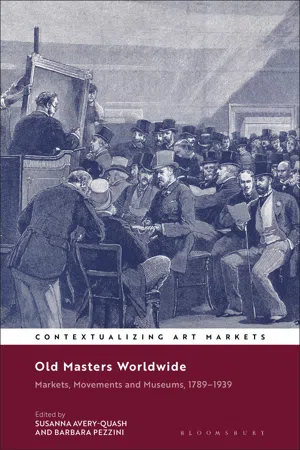![]()
Part One
Developing European Networks, 1780–1894
![]()
1
The European Market for Italian Old Masters after Napoleon
Robert Skwirblies
The period between the end of the Napoleonic Wars and the beginning of the series of new revolutions (1815–30) was to define the market for Old Master paintings for the entire nineteenth century.1 Although brief, these fifteen years were crucial for three main reasons: above all, a large quantity of works of art circulated throughout Europe, including a vast amount of objects previously smuggled or traded during the post-revolutionary years. Second, an increasing number of effective collaborations were established between state officials, collectors and dealers. Sometimes one person fulfilled all three roles, but, generally speaking, the dealer became a noticeably more independent agent during the period under review. Finally, increasing knowledge about and demand for old paintings was intertwined with the rise of public museums with active acquisition policies.
This chapter will focus on the turning point for the development of the market for Italian Old Masters, with a brief investigation of those protagonists and collections that represent key moments in that story. The methodological approach has been to draw general conclusions from analysing and comparing specific case studies, an approach best suited to the limited availability of empirical evidence.2 Indeed, the main difficulty for the historian is the lack of primary source material in this area: much of the trade was not documented, which is not surprising given that a large part of it was conducted in violation of export restrictions or simply to avoid paying taxes.3 An exception is the cache of family letters of Vincenzo and Pietro Camuccini dating to the Napoleonic era, which gives an idea of these dealers’ clandestine methods of bringing Old Master paintings of the highest quality from Rome to England for sale.4 They can be studied alongside the letters of two British art dealers, William Buchanan and John Smith, an exercise which sheds useful light on the contemporaneous British context.5 In most cases, though, hints and claims about smuggled works of art and dubious sales are often all that is left, which has led to speculation about the sums of money involved in various transactions.6 Further difficulties for historians arise in relation to attribution and identifying the works of art mentioned in primary documentation: official documents such as licenses, inventories and sale catalogues provide only an asserted authenticity so that, in most cases, it cannot be proved whether an offered or examined picture was an original, a copy, a forgery or a painting by another hand.7 What can be said, even from analysing only the preserved export licenses usually issued by professors and functionaries of the Florentine and Milanese art academies or the papal court (and appointed for that purpose), is that there was a noticeable increase in export activity during the period, even while there were increasingly public debates about the value of works of art as national or cultural treasures that should be protected.8
Conditions for a Thriving Art Market
During the first fifteen years of the nineteenth century, the documented number of Italian paintings brought to auction according to the data in the Getty Provenance databases was over 32,000, a third higher than in the previous twenty years, and forming an exceptional peak.9 However, in the following years between 1815 and 1830, there were still another 27,000 lots of Italian paintings listed in sale catalogues.10 This generic observation concurs with the high number of – mostly undocumented – mass auctions and sales in Italy during and after the late Napoleonic period (Fig. 1.1).11 Hundreds, and sometimes thousands, of paintings might be sold during one auction; the pictures sold were mostly not by famous top-end masters with equivalent high prices, but were anonymous or minor works.12 Such objects very often found their way into sales abroad given that the lower their estimated value was, the lower the associated fees and taxes were.13 Indeed, the export restrictions that were reinforced by law in Tuscany in 1817 and also two years later in northern Italy14 were concentrated on objects considered precious and significant for the country’s identity.15 In a similar vein, the Pacca Edict of 1820 strengthened the export controls in the Roman Papal State, and again only really affected the most esteemed, and hence most expensive, paintings.16 These measures to enforce control led to an increasing number of fine art objects being officially presented, and then marked and sealed for exportation in the following years, which had the knock-on effect that, in 1823, the Florentine Academy introduced printed forms for the purpose.17 This increase in paperwork had its own problems because individual states in the Italian Peninsula lacked sufficient resources to deal with the sheer number of requests. Consequently, to speed things up and to facilitate trade in the art market, in 1830, the Brera Academy in Milan, responsible for the examination and authorization of paintings that were to leave the state, supported a dealer’s request to shorten the bureaucratic procedures.18 Similar tendencies can be identified in Bologna, where already in the early 1820s the Academy was greatly in favour of allowing paintings...
